How this is below 1 million views is beyond me. Maybe it’s the Canadian humour. Damn!
Oh well, keep your stick on the ice.

How this is below 1 million views is beyond me. Maybe it’s the Canadian humour. Damn!
Oh well, keep your stick on the ice.
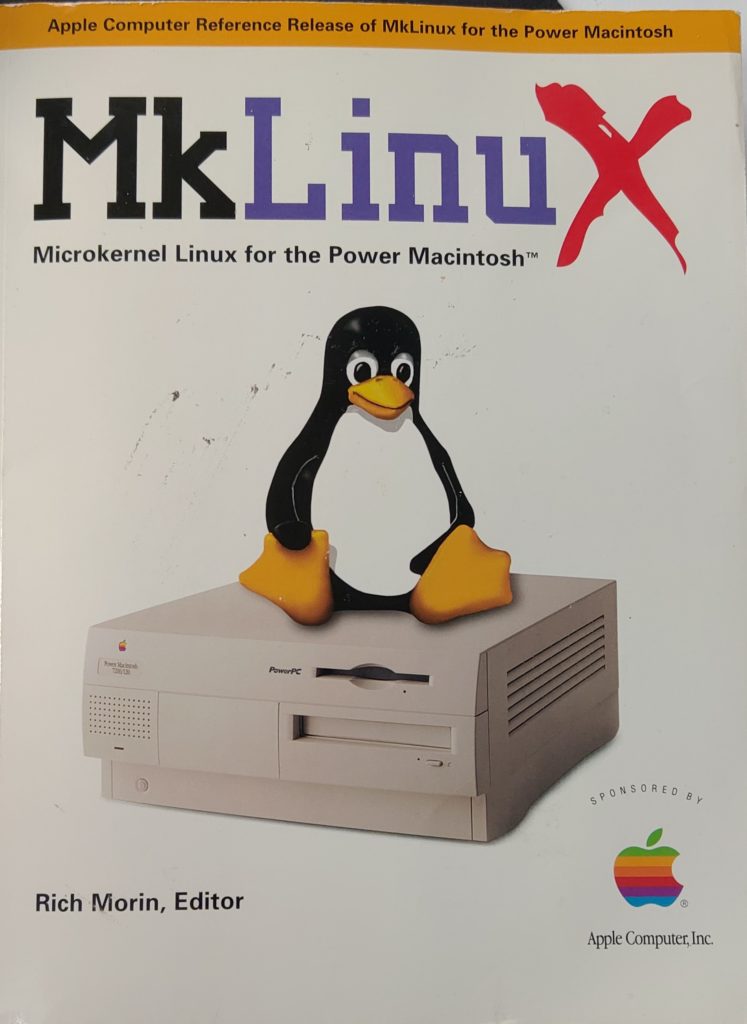
Or how I finally broke down and bought that MkLinux book after all these decades. When I did own a PowerPC Mac as my daily driver it was an iMac back in 1999 and I ran OS X Server. I later bought a G4 to only find out that OS X didn’t support the G4. Linux had issues too and I ended up running OpenBSD on the G4. Which was fun, although for the ‘work at home’ bit, I ended up needing Windows NT 4.0, so I ran that in OS 8 on SoftPC. Yay.
I didn’t have any luck with Linux on Power as MkLinux wanted the beige hardware, and by the time I felt like digging in again to Linux, OS X had finally been ported to the G4 Sawtooth’s so it really didn’t matter.
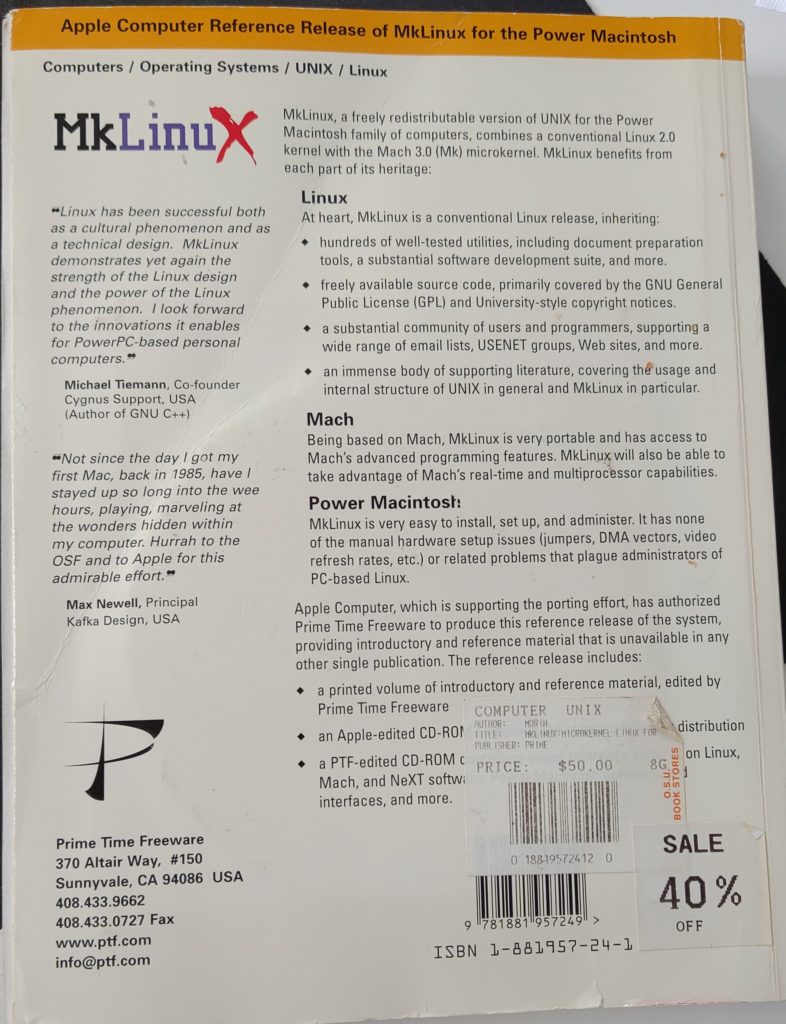
I’d seen this book in a store but it was pretty expensive, and geared to such a tiny market. Although Mach does compile on the i386, why they didn’t include it was well to push Mach/Linux as a platform well that’s beyond me. Then again looking at the stunning success of Darwin on i386/x86_64 I guess the reality is, why bother.
I ordered this on Ebay, for the usual $5 plus $10 to ship, and it just showed up today! What mysteries lie on the CD-ROMs? I know others have posted stuff, but I wanted to hold them in my hands myself.
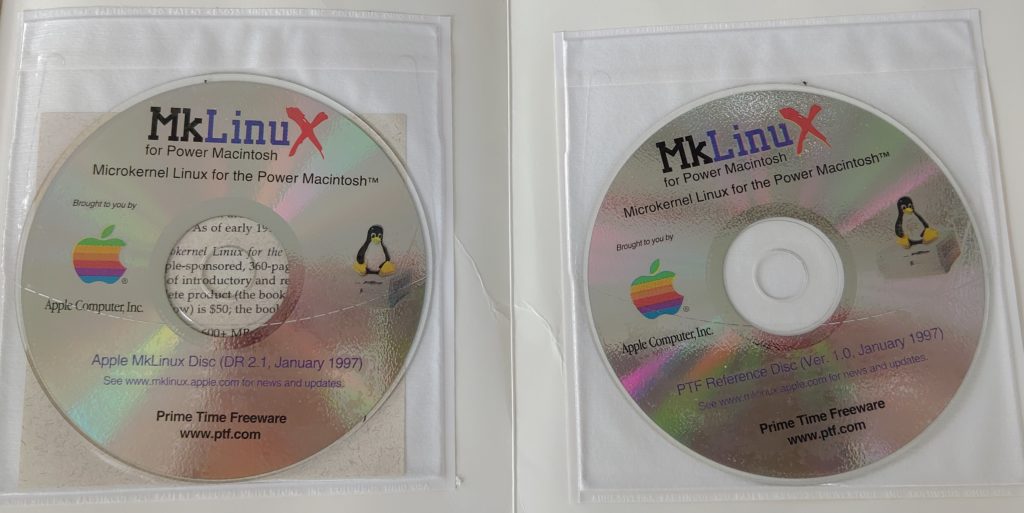
I didn’t know if the CD-ROM’s were included, and I first thought I got lucky: not only were they included, neither had been opened up before! These CD’s had been packed way like this for the last 22.5 years! Now for the bad part.
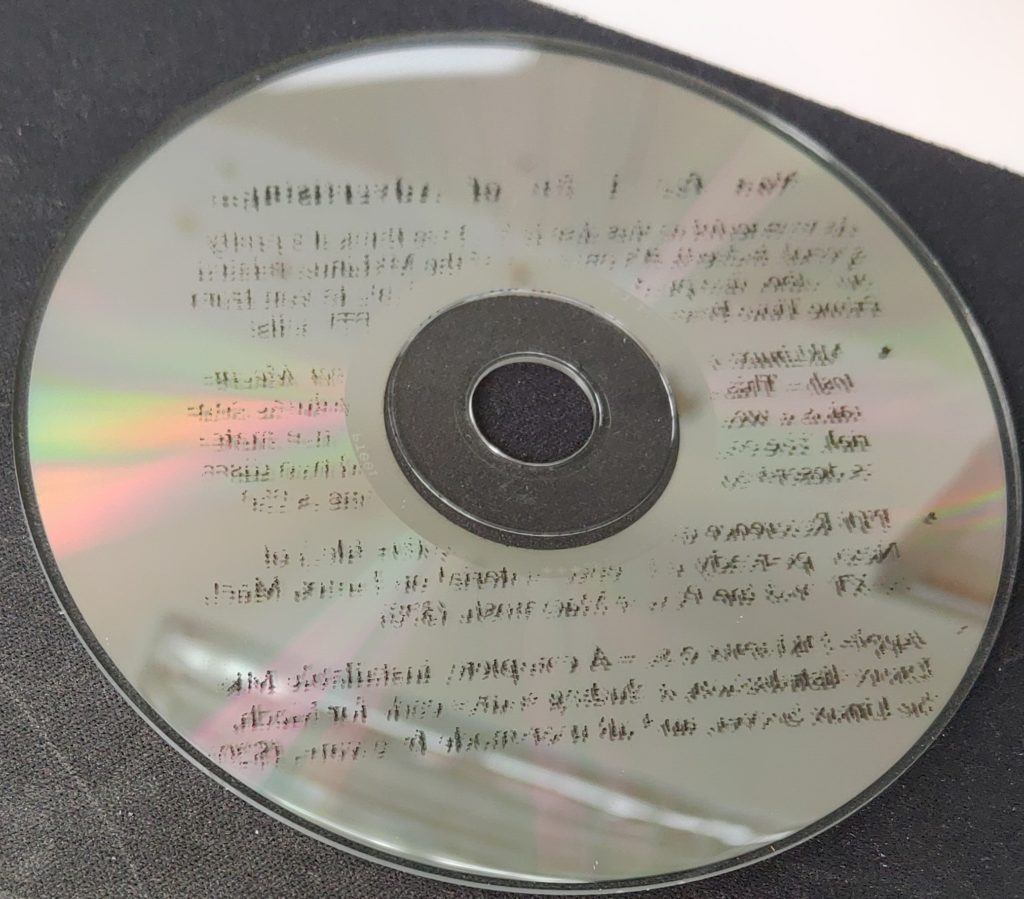
See that stupid leaflet in the back? Yeah well it turns out that it was a really stupid idea. No doubt this thing sat in the bottom of a stack for decades where the ink had been pressed for so long against the disk that it has transferred to the surface.
HOW ANNOYING.
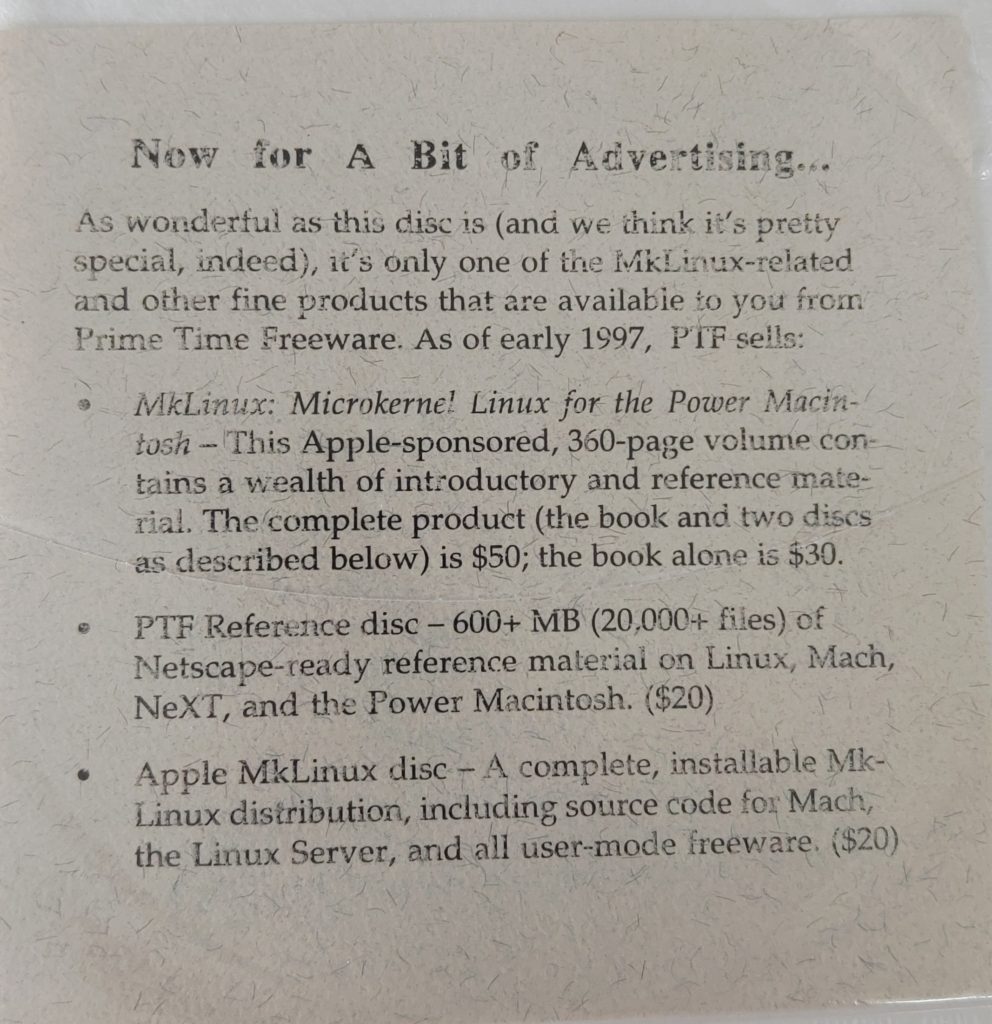
So yes, they actually advertise the book, namely the one that I had bought with some crap ink leaflet in the CD-ROM pouch and it’s transferred to the disc.
Sigh.
I tried rubbing alcohol but that had no effect. I tried rubbing with a credit card, and it got a little off, but I fear I’m just going to damage the surface more.
I can only imagine what other CD-ROM’s out there that haven’t been archived are sitting under hundreds or thousands of pounds of book weight having nonsense imprinted onto them.
At least the second CD-ROM doesn’t suffer this defect and I’ll be uploading it later.
No book review yet, I’m just sitting here with this impacted CD.
UPDATE
Thanks to Shawn Novak for uploading the R3 images so I can at least pull up the compatible machines:
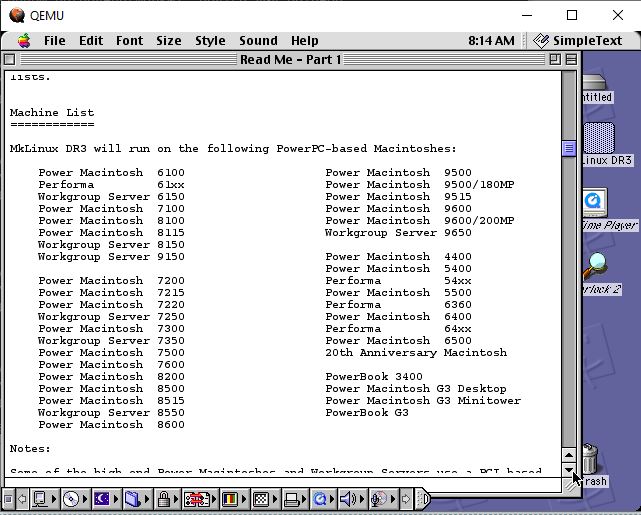
The latest Qemu can pull it the image fine, however trying to boot up looks like the Mach kernel just isn’t compatible enough with the emulated Mac99 machine (which isn’t surprising).
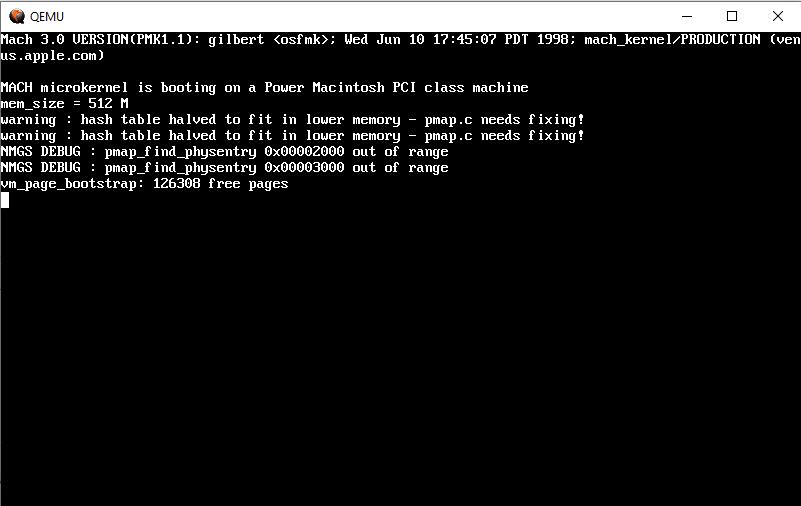
I’ll need to mess with stuff to see if the G3beige can boot Linux on Qemu, and if the BootX (I think it’s bootx?) can load the mach kernel.
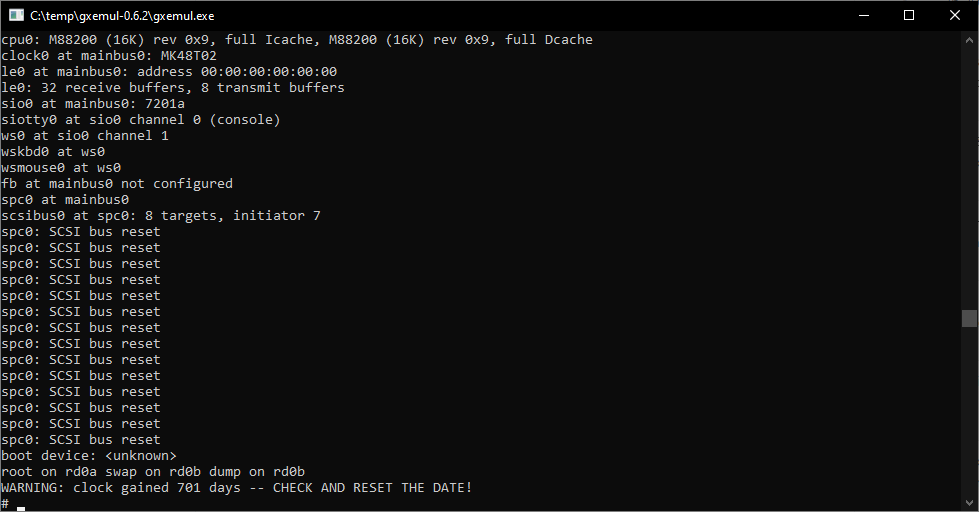
Don’t get all to excited, it’s a terrible port, but it’s to the point where it can barely run stuff. Although I don’t know how much is me, and how much is GXemul. I probably should have tested on Linux first.
Anyways it’s enough to boot the Luna m88k OpenBSD ram disk up to the single user mode, and poke around. The hard disk doesn’t pick up, and I haven’t even tried the NIC, although the address is looking pretty bogus.
I wanted to try the PMAX version of Mach, but then it hit me, that there is no server to load. And porting the system level from Mach 3.0 to 2.5 looks way more involved than Mach 3.0 being ‘something minor’.
Back on the 88k front, the Luna shipped with something called UniOS-Mach, but good luck finding that in this day & age. I guess I’ll have to go back to Japan.
For the crazy among us, go ahead and try gxemul-0.6.2-ultra-primative.zip The name says just how stable it is.
In the meantime here is a super low resolution capture of the screensaver from a Luna via http://www.nk-home.net/~aoyama/luna88k/
As an update, I added in the timer code from PCemu, and now that the timers appear to be firing some stuff like OS/F 1.0 get’s further!
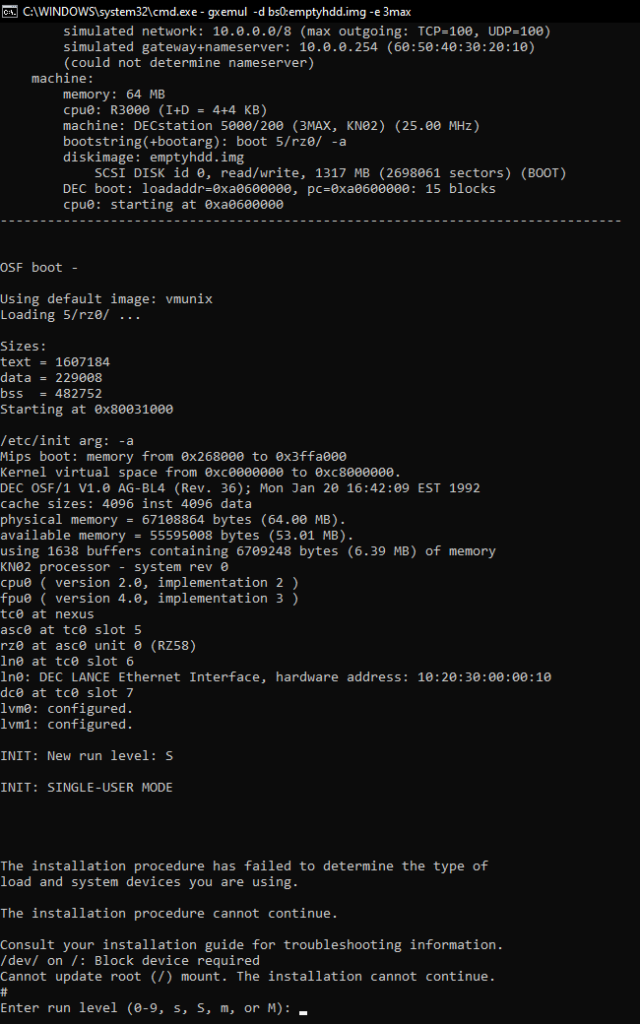
I need to go through the setup stuff a lot better as this is just untar’d and not setup at all. Not that it’s useful, but here, osf1-barely.7z .
So if anyone downloaded gxemul prior to this update, re-download it again! I put the m88k ramdisk kernel in there too so you can quickly test the Luna 88k emulation.
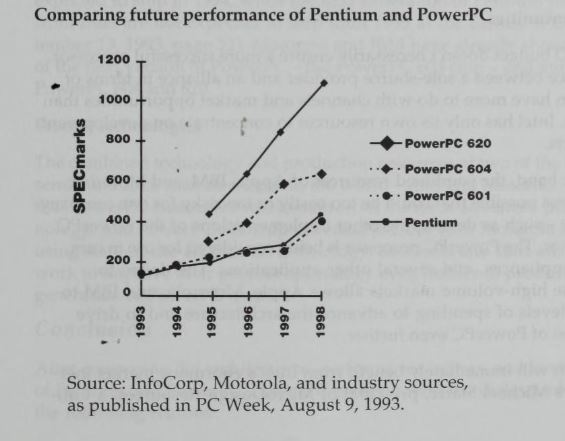
The Pentium processor, like the 68060 was the end of the line, there was nothing more that could be done for CISC, the future was RISC, and Intel along with Motorola had painted themselves into the corner, and the only way out was RISC. But both the i860 & 88010 failed to gain critical traction, paving the way for AIM to deliver on the PowerPC, leaving Intel behind.
Except it didn’t.
It’s always somewhat amusing and disappointing re-reading old stuff, looking for things and finding stuff like this.
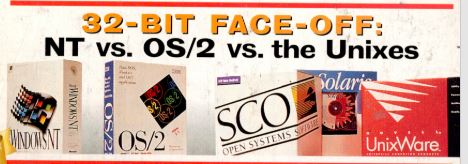
Just as 1993 was the year that brought Windows NT out into the world, and the 32bit x86 wars really ignited. Who would have thought that only NT would remain out of these 5, and that ‘school kids project’ would have eclipsed them all?
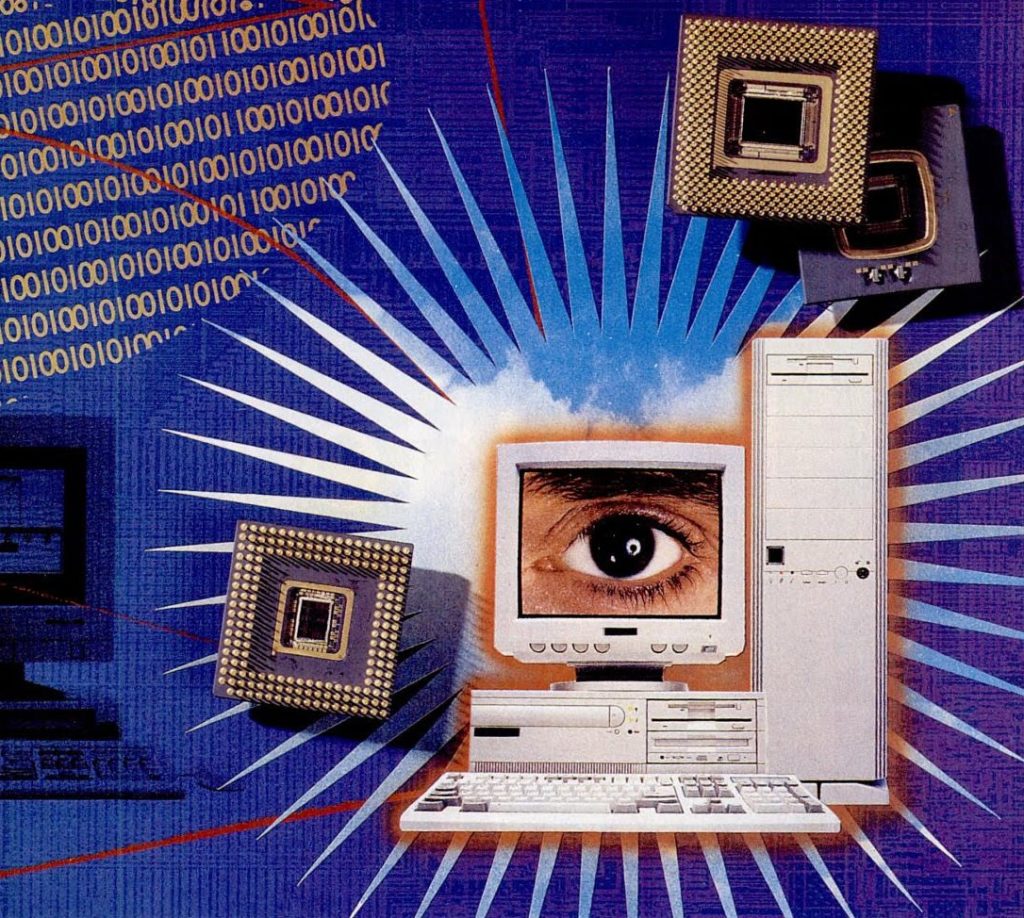
There was something always ‘cool’ about the 80/90’s computer magazines and their shameless clip art, art packs. I wonder how much was physical cut outs and photographs vs being all digital? The shadows on the processor pins & heat sinks make me think that this was a physical layout.
For a fun call back, check out the May 31st 1994 issue of PC Magazine, PowerPC vs Pentium. It surprisingly has a lot of RISC reviews past page 120.
As luck has it, the 620 was delayed, and did not launch in 1994. It wouldn’t be pushed out until 1997, and by then the performance was lackluster, and I think this is what pushed IBM back into the POWER processor business. Making this the foreshadowing of abandoning Apple yet again with the G5 years later, despite IBM’s massive sales of PowerPC’s to Microsoft, Sony & Nintendo for various games consoles getting the volume that they desperately wanted to only later hand it over to AMD & ARM.
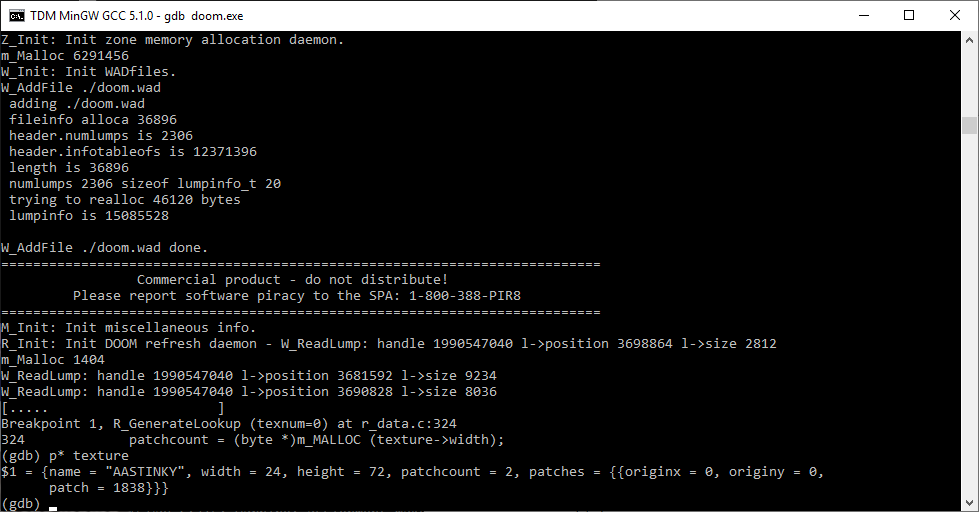
On the i386 a texture info lump loads up just fine. However on a big endian G5…
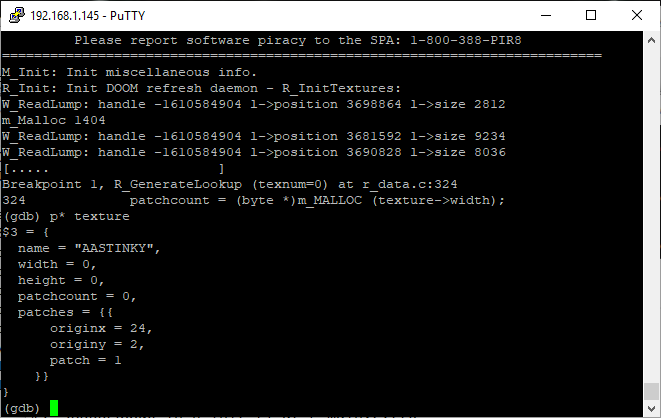
…It clearly has problems. Although notice that the positions and sizes are the same, as they ought to be.
Notice how originx is 24, which should be the width. This code was running with GCC 1.30/1.40 hammered x68000 GCC. Although I have been unable to get the much vaulted gcc-1.30.atari.tar.bz2 to do anything useful, well until tonight, when I found this file: GNU_HEAD.ARC.
That’s right, it’s the gcc-1.23 release headers for GCC on the Atari ST. Now I know other places people have been saying I should use MINT or some GCC8 port. And I wanted something to run on bare TOS, and I cross compiled the simple Infocom interpreter but it just crashes out after a few commands. It’s hardly stable.
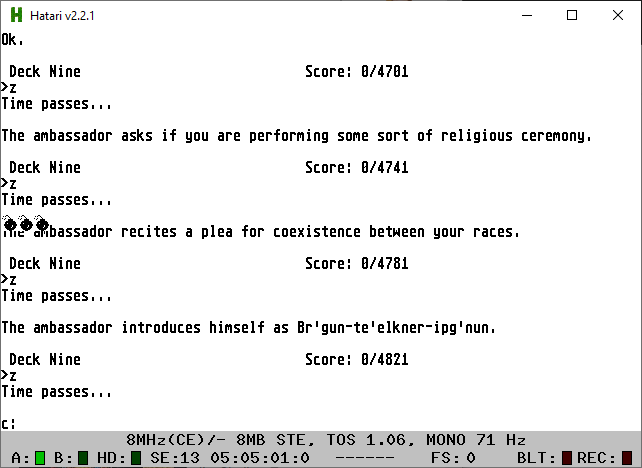
Which is just a damned shame, as it was easier to just download someone else’s work.
Anyways, I now can build the old gcc-1.30 libc however… the linker that I’m using that works for GCC 2 links away and it looks like a working program but it doesn’t do anything. I have a feeling the linker drifted in those years between GCC-1.30 and GCC-2.something when it was adapted. Certainly by the time of 2.5.8. So yet more endian ghosts to chase down if I try to adapt that linker.
(This is a guest post by Antoni Sawicki aka Tenox)
Apps for Windows NT RISC… Alpha AXP, MIPS and PowerPC. Happy downloading.
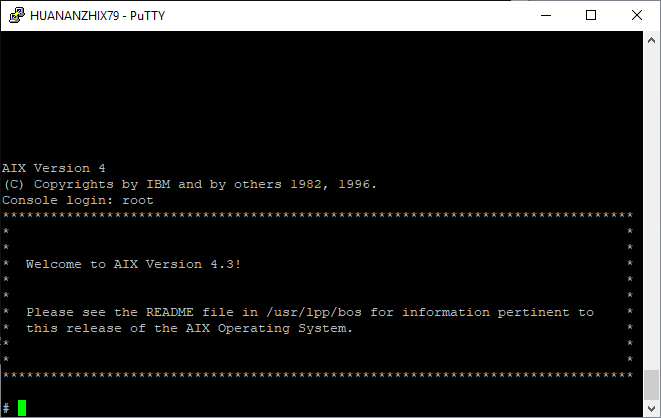
YES it’s real!
I’m using the Linux subystem on Windows, as it’s easier to build this Qemu tree from source. I’m using Debian, but these steps will work on other systems that use Debian as a base.
First thing first, you need to get your system with the needed pre-requisites to compile:
apt-get update;apt-get upgrade
apt-get install build-essential pkg-config libz-dev libglib2.0-dev libpixman-1-dev libfdt-dev
Great with those in place, now clone Artyom Tarasenko’s source repository
git clone --branch 40p-20190406-aix-boots --single-branch https://github.com/artyom-tarasenko/qemu.git
*NOTE from the future (2022) you may want to jump here: to check out building on newer systems. Also don’t forget about networking!
Since the frame buffer apparently isn’t quite working just yet, I configure for something more like a text mode build.
././configure --target-list=ppc-softmmu --disable-sdl --disable-vnc --disable-gtk --disable-gnutls --disable-nettle --disable-gcrypt --disable-spice --disable-numa --disable-libxml2 --disable-werror
Now for me, GCC 7 didn’t build the source cleanly. I had to make a change to the file config-host.mak and remove all references to -Werror. Also I removed the sound hooks, as we won’t need them. remove the following lines:
CONFIG_AUDIO_DRIVERS=oss
CONFIG_AUDIO_OSS=m
Now you can build Qemu. it’ll happily build in parallel so feel free to build using the -j parameter with how many cores you have. I have 32, so I use
make -j32
Okay, all being well you now have a Qemu. Now following the steps from
Artyom Tarasenko’s blog post, we can get started on the install!
First we create a 8GB disk
qemu-img create -f qcow2 aix-hdd.qcow2 8G
Next we need the custom BIOS with serial as the console.
wget https://github.com/artyom-tarasenko/openfirmware/releases/download/40p-20190413/q40pofw-serial.rom
You’ll need some AIX. I tried a 3.2.5 CD-ROM and it didn’t pick up, but AIX 4.3.3 did.
Now with all those bits in place, it’s time to run Qemu.
./ppc-softmmu/qemu-system-ppc -M 40p -bios q40pofw-serial.rom -serial telnet::4441,server -hda aix-hdd.qcow2 -vga none -nographic -net none -cdrom Volume_1.iso
Now telnet to your localhost on port 4441 and you will see the console doing it’s BIOS initialize and eventually drop to the OK prompt.
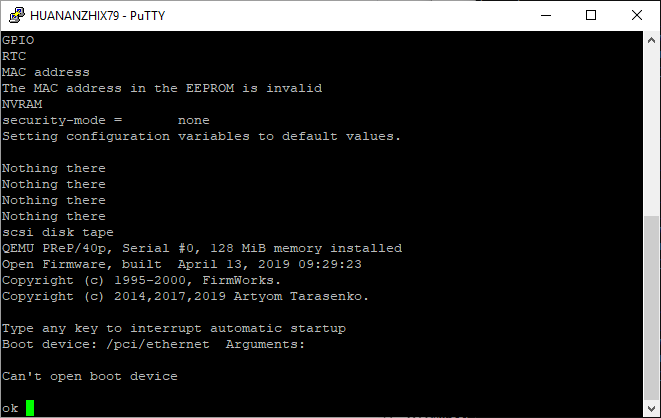
One trick I’ve found is that from the Open Firmware prompt you can find out what partitions are recognized from the firmware. If it see’s partitions then there is some hope that the image you have is valid enough to boot. In the last few days I’ve found quite a few AIX images, which are lacking the partition table, and unable to boot.
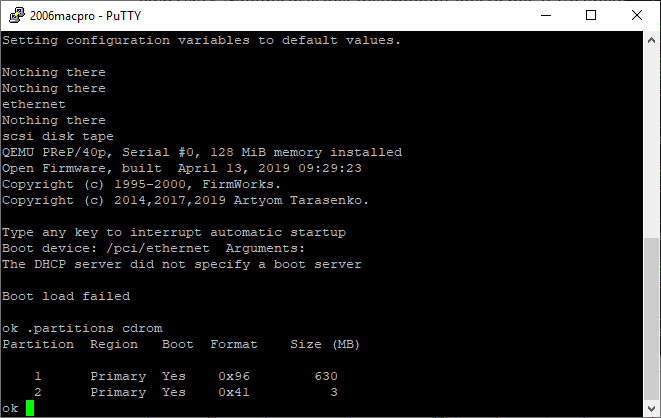
simply type in boot cdrom:2 to kick off the installer. It may take a minute or so for the installer to kick off.

If all goes well, you’ll see the BIOS reload itself, then after a minute you’ll be prompted to press 1 to select the console
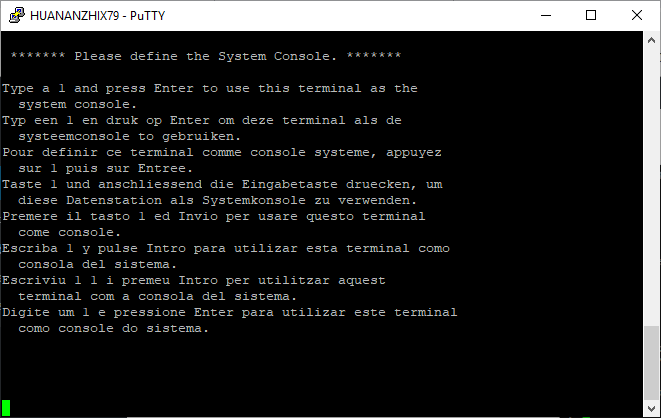
It doesn’t echo, don’t panic!
Next select your language. I’m doing English.
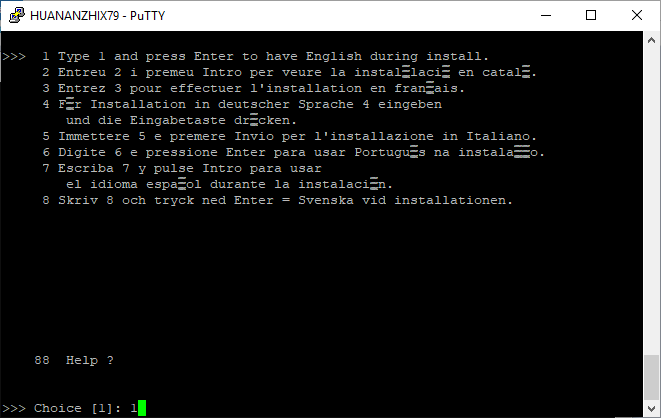
Next it’ll ask about installation type. Default ought to be fine.
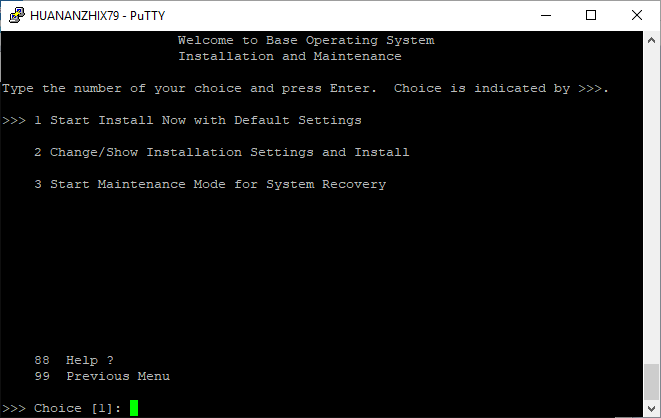
Because this will destroy the contents of the disk (which doesn’t matter as it’s blank) it’ll prompt for confirmation.
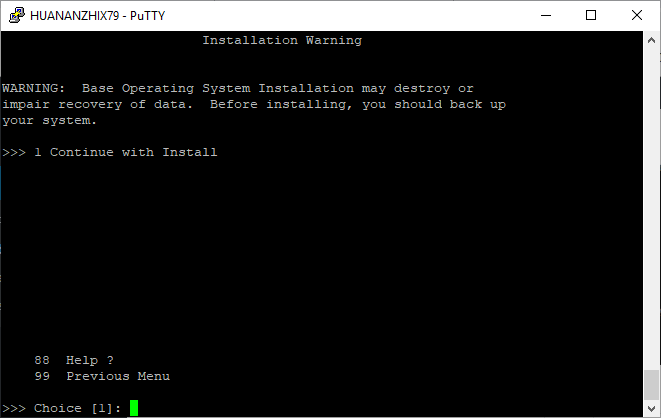
After this it’ll begin the installation. Depending on how fast your disk & CPU is this will take a while.
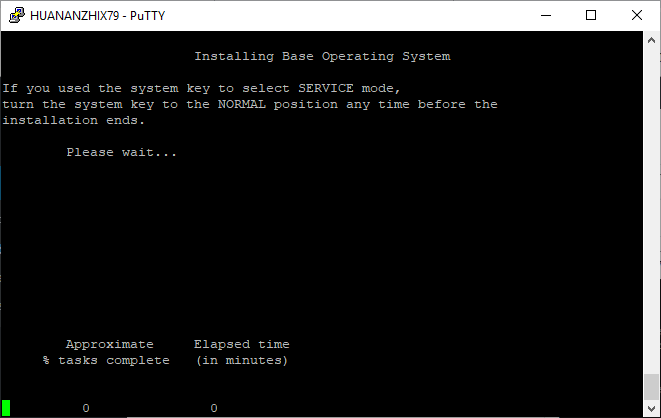
For me, the installation took about 11 minutes. This is using my Xeon E5-2667 v2. It took 17 minutes on my 2006 Mac Pro, with X5365’s it .
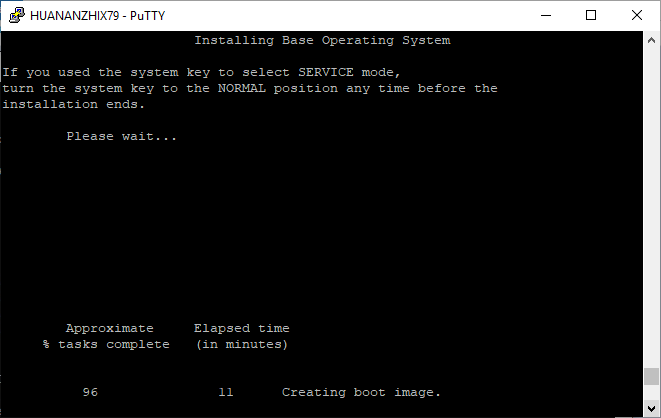
After it’s done, right around the 96% time it’ll reboot back to the BIOS
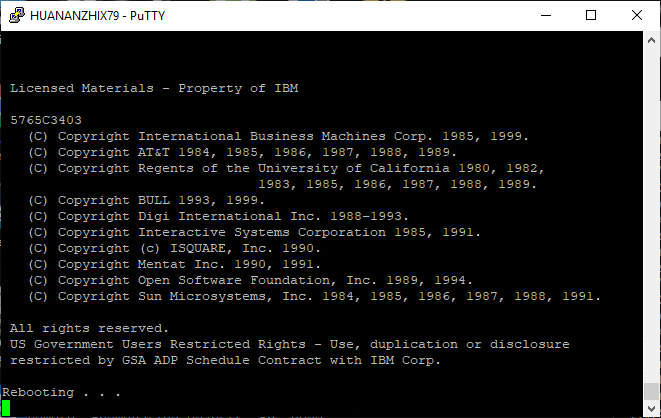
Once you are back at the OK prompt, you can now boot disk:
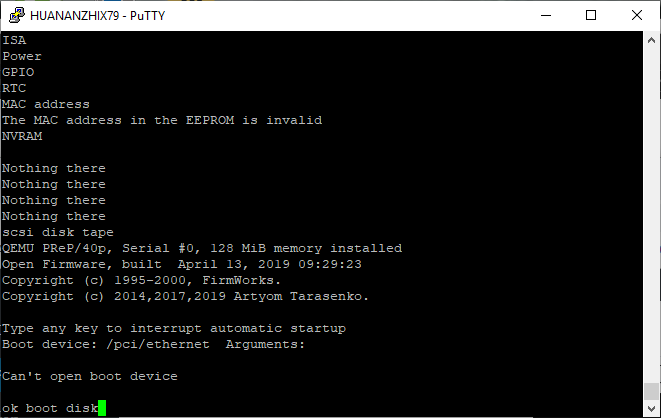
it’ll look like it’s hung for a minute, then it’ll start booting from disk!
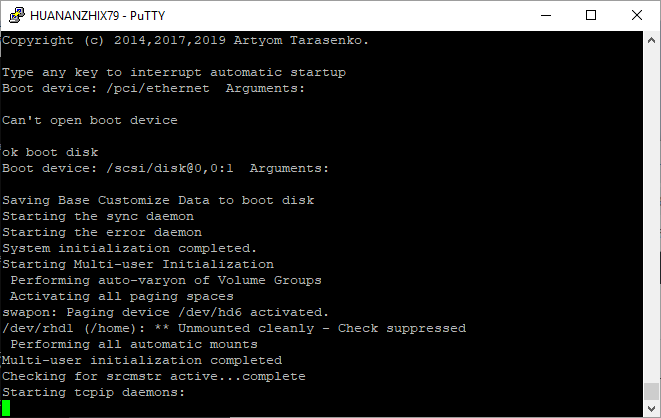
Once the OS is booted up, you select the terminal type. I’m using putty but I’ll select the vt100. Of note the function keys are selected by hitting escape and then the number key. So F3 is ESC 3.
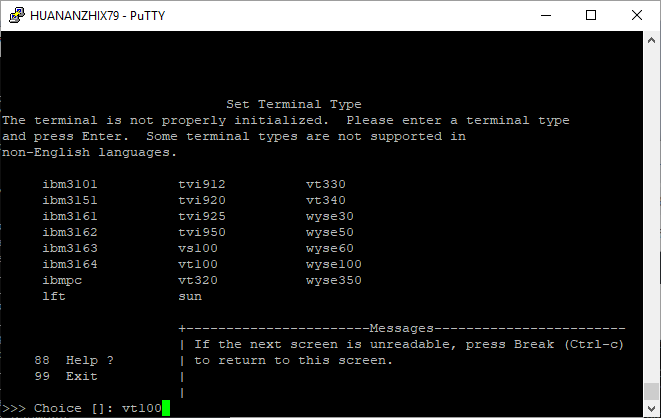
I’m just going to finish the install, as we can always run smitty to mess with the system more, but right now I’m just interested in a base install of the BOS (Base Operating System, and IBM ISM).
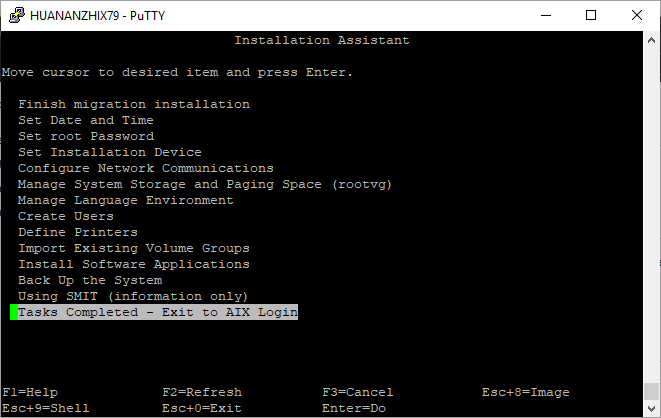
A few moments later, you’ll get dumped to the login prompt.
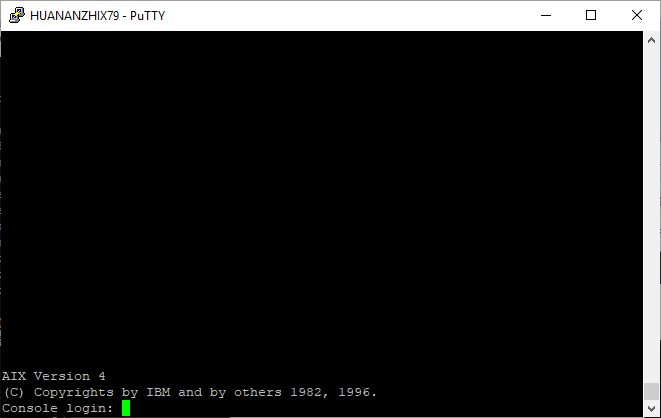
By default there is no password, so just login as root, and there you go, your very own virtual AIX 4.3 system.
# uname -a
AIX localhost 3 4 000000004C00
So there you go! All thanks to Artyom’s hard work!
I just got another PowerBook, and the disk had been wiped by the prior user, and all it did was boot up to the blinking mac face. So not very useful. I did luckily buy some CD’s from a user on reddit a few months ago, so I had 10.4 install DVD, and an install of 9.2.2 for the emac.
Now the OS 9, is an install disc, not one of the recovery discs, and naturally the aluminum powerbooks don’t boot OS 9, so I’m kind of out of luck for getting Classic working, or so I had thought. I copied the System Folder from the CD onto the hard disk, and told the classic applette to boot it, and it updated some system files, and then gave me this fine message:

So this got me thinking, back in the Sheepshaver days when trying to boot from an ISO as a disk file, it fails the same way because the image is read/write. If it’s read-only it does boot up however. So I used disk util, and made a new read-only disk image from a directory, and pointed it to a directory that I’d moved the CD’s system folder, desktop to. After mounting the read only image, it booted!
Now for the best part, I then kicked off the installer from the CD, and had it install a copy of OS 9, onto the OS X disk.

It’s worth noting that just about every optional install fails. It’ll come back with an error, and you can skip the component. It’s probably just easier to install the minimal OS image.
But rest assured it really does install.
After the install you can eject the CD, unmount the read-only copy and tell the classic to stop and then boot from the new installed copy of OS 9 on the OS X disk. It didn’t interfere with my OS X from booting, although the ‘sane person’ would probably have disk image make a small (1gb) read/write virtual disk, and have the installer install to that.
So to recap, copy the system folder from the CD onto read-write media, and let classic update it. get it to the point that it’s not happy about being mounted read-write. Move it to a read-only disk image and have classic boot from that, and then run the OS 9 installer to install itself to whatever target disk you need or want.
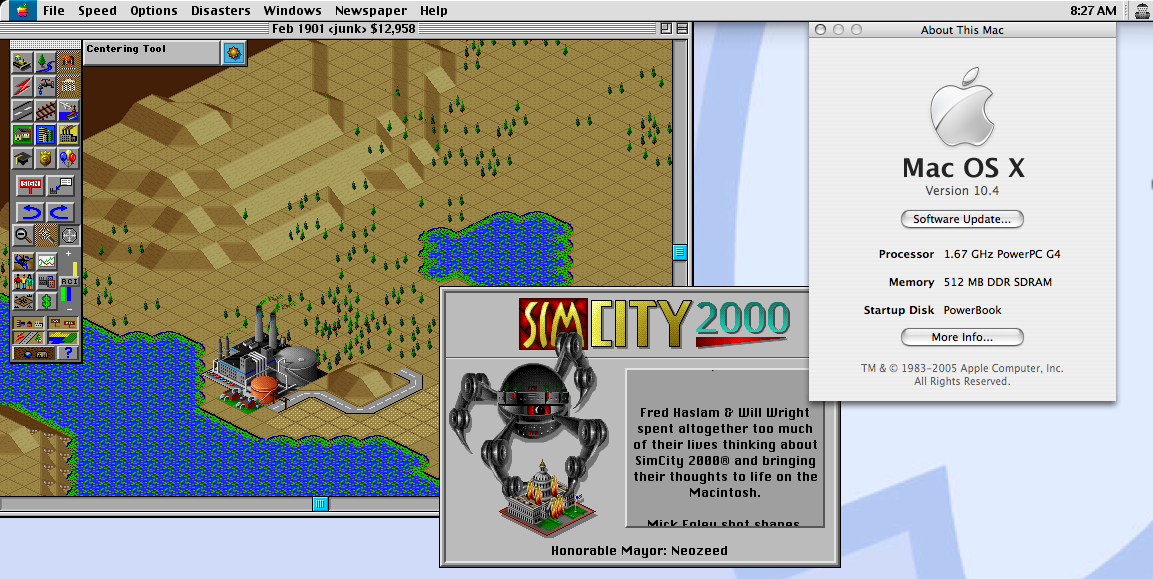
I’ve run Netscape 4, IE 3 & 4, QuickTime 4, and the SIMS version 1 (the OS 8/9 carbon version). using 10.4.0 on an aluminum powerbook.
I don’t know if anyone else has done this, I couldn’t find any real concrete guides for installing OS 9 from OS X. So here we go.
Wow the time sure flies!
(Video in MPEG-1/Audio MPEG-2 care of JSMpeg).
I know it's terrible quality but finding video from these old Apple events seems to have been recorded on VHS, and then re-recorded using the 'best' video capture technology for under $100 of the era leading to some really poor quality. Such is the internet I guess.
I didn't buy a first generation but I did have a 2nd generation 333Mhz green iMac to run OS X Server 1.0 ... Who wasn't excited for the prospects of the next millenium?
In my last trip to the United States, I scored yet another PowerMac G5, a model 7,2 which is one that is capable of running OS X 10.2.7 for the G5. It was the proverbial dream come true, used by an elderly man to keep track of photos in iPhoto, which he used maybe a handful of times a year.
Needless to say, he wasn’t too pleased that his copy of Snow Leopard didn’t work on the machine, and he dumped the G5 for a much quieter MacBook.
At any rate, it also included an Apple Studio Display. I found another Cinema Display in the used hardware market for $25, which even though the display works the screen was damaged at some point and shows scratches on the surface when the display is a solid colour.
At any rate, the machine was deadly slow to boot, I upgraded the RAM from 256MB to 1.2GB, and replaced the ancient disk for a SAMSUNG SSD PM830 2.5 256GB flash drive. Now it’ll boot up in under 30 seconds from the graphics initialization.
That makes this the only machine I have capable of running MacOS 9, although in emulation under OS X 10.2. I have the Jaguar DVD set, but Classic mode was removed in 10.5. It was the ending of the PowerPC era, just as 10.6 was the last version to ship with Rosetta.
Its a fun machine from the era of the introduction of personal 64bit RISC computing to the home user, although too bad the full industry didn’t catch up until later, just as 32bit desktop computing had a few stumbles out of the gates.